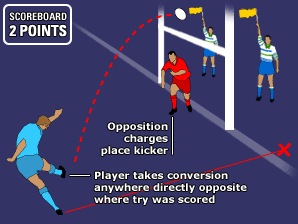Scoring points in rugby is crucial to winning. There are several ways to do this.
Rugby is a dynamic and exciting sport. Whether you’re a player or a fan, understanding how to score points is key. From tries to conversions, each method adds a unique twist to the game. This guide will help you learn the different ways to score and what each one means.
Get ready to dive into the world of rugby scoring and enhance your appreciation of this thrilling sport.

Credit: www2.gvsu.edu
Introduction To Rugby Scoring
Rugby is a sport filled with excitement and strategy. Scoring points is essential to winning the game. Understanding how to score is crucial. This guide will help you learn the basics of rugby scoring. It will also show the importance of points in the game.
Importance Of Points
Points determine the winner in rugby. They reflect a team’s skill and strategy. Every point counts and can make a big difference. Teams work hard to score as many points as possible. Points can come from different actions on the field.
Basic Scoring Methods
There are several ways to score points in rugby. Each method has its own value. Here are the main ways to score:
- Try: A try is worth 5 points. It is scored by grounding the ball in the opponent’s in-goal area.
- Conversion: After a try, a team can kick a conversion. This is worth 2 points. The ball must go through the goalposts.
- Penalty Kick: A team can score 3 points with a penalty kick. This is awarded for certain fouls by the opposing team.
- Drop Goal: A drop goal is worth 3 points. It is scored by drop-kicking the ball through the goalposts during open play.
Let’s break down each method further:
| Scoring Method | Points | Description |
|---|---|---|
| Try | 5 | Grounding the ball in the opponent’s in-goal area. |
| Conversion | 2 | Kicking the ball through the goalposts after a try. |
| Penalty Kick | 3 | Kicking the ball through the goalposts following a foul. |
| Drop Goal | 3 | Drop-kicking the ball through the goalposts during open play. |
Each method of scoring requires skill and precision. Teams must practice these methods to score effectively.

Credit: www.youtube.com
Tries: The Ultimate Goal
Learn how to score rugby points with tries. A try earns the most points by grounding the ball in the opponent’s in-goal area. Perfecting this skill can lead to victory.
In rugby, scoring a try is the ultimate goal. It brings the most points and excitement to the game. Players push their limits to achieve this. Let’s dive into the basics and techniques.What Is A Try?
A try is worth five points. To score, a player must ground the ball in the opponent’s in-goal area. This area is beyond the try line. It sounds simple, but it requires skill, teamwork, and strategy. The player must have control of the ball when grounding it. Both hands or one hand can be used. The ball must touch the ground firmly.Techniques To Score A Try
Scoring a try involves various techniques. One common method is the dive. Players dive to avoid tackles and reach the try line. Another technique is the sidestep. This move helps to evade defenders. Speed is also crucial. Fast players can outrun opponents and score. Teamwork plays a big role. Passing the ball swiftly can break through defenses. Offloads, where players pass while being tackled, keep the play alive. Dummy passes trick defenders and create openings. Awareness of the field is essential. Players must spot gaps and exploit them. Understanding these techniques can help any rugby player. Practice and experience will improve their chances. Scoring a try is thrilling and a key part of the sport. “`Conversions: Adding Extra Points
Scoring a try in rugby earns your team five points. But there’s more! After a try, your team gets a chance to earn extra points through a conversion kick. This kick can add two more points to your score. Conversion kicks are crucial. They often decide the outcome of the game.
Conversion Rules
The conversion kick must be taken in line with where the try was scored. The player can choose the distance from the try line. The kick must be within the field of play. The goal is to kick the ball through the uprights and over the crossbar.
| Rule | Details |
|---|---|
| Placement | In line with where the try was scored |
| Distance | Player’s choice within the field of play |
| Goal | Through uprights, over crossbar |
Kicking Techniques
Different players have different styles for conversion kicks. Some prefer a straight kick. Others use a curved kick. Both methods aim to score those vital extra points.
Here are some common kicking techniques:
- Place Kick: The ball is placed on the ground. The player kicks it from a stationary position.
- Drop Kick: The ball is dropped from the hands and kicked as it touches the ground.
- Spiral Kick: The ball is kicked with a spiral motion, making it spin in the air.
Practicing these techniques improves accuracy and consistency. Each kicker has their own preference. It’s about finding what works best for you.
Penalty Kicks: Capitalizing On Opponent’s Mistakes
In rugby, penalty kicks are a golden opportunity to score points. These kicks arise from the opponent’s mistakes. They can be a turning point in the game. Understanding when and how to take these kicks is crucial. Let’s dive deeper into the specifics.
When To Take A Penalty Kick
A penalty kick is awarded for several reasons. Common ones include offside, high tackles, and not releasing the ball. The referee signals the infraction. The team can then choose to kick for goal, kick for touch, or take a scrum.
| Infraction | Definition |
|---|---|
| Offside | Player is ahead of the ball or last teammate. |
| High Tackle | Tackle above the shoulders. |
| Not Releasing | Player holds the ball on the ground. |
The decision to take a penalty kick depends on the team’s strategy. If close to the goalposts, a kick for goal is often the best choice. It offers a chance to add three points to the score. The distance and angle to the posts are also considered. The kicker’s confidence and skill level play a role too.
Accuracy And Power
A successful penalty kick requires both accuracy and power. The kicker must aim between the uprights. A calm and focused approach is essential. Practicing the kick regularly improves accuracy. The kicker’s position and posture affect the kick’s success.
Power is equally important. The ball must travel the necessary distance. A strong leg and proper technique are crucial. The kicker should follow through with their leg to ensure the ball’s trajectory. Wind and weather conditions also impact the kick. Adjustments may be needed based on these factors.
- Keep eyes on the ball.
- Plant the non-kicking foot firmly.
- Follow through with the kicking leg.
Combining accuracy and power increases the chances of scoring. Regular practice and focus during the game are key. Penalty kicks can significantly impact the game’s outcome.
Drop Goals: A Tactical Advantage
Drop goals can change the course of a rugby match. This technique is often underestimated. Yet, it offers a strategic edge. Mastering drop goals can make a significant difference in scoring points.
Understanding Drop Goals
A drop goal is worth three points. It occurs during open play. The player drops the ball and kicks it as it bounces. Timing and precision are crucial. Drop goals are often used in tight matches. They provide a quick way to add points to the scoreboard.
Execution Tips
Executing a drop goal requires practice. Here are some tips to help you:
- Positioning: Ensure you are in a good position. Ideally, aim to be in the center of the field.
- Focus: Keep your eyes on the ball. Focus on the bounce and the kick.
- Foot Placement: Place your non-kicking foot close to the ball. This provides better control.
- Follow Through: Follow through with your kick. This ensures accuracy and distance.
Use these tips to improve your drop goals. Practice regularly. Consistency is key to mastering this skill.
Teamwork And Strategy
Rugby is not just about individual skill; it’s about the power of teamwork and strategy. Every player, every pass, every kick counts. Success hinges on how well the team works together. Let’s delve into the importance of teamwork and strategy in scoring points in rugby.
Role Of Forwards And Backs
Forwards and backs play distinct roles in a rugby team. Forwards are usually bigger and stronger. They win possession of the ball in scrums and lineouts. Their primary job is to gain ground and retain the ball. They support the backs by providing a solid platform to launch attacks.
Backs, on the other hand, are typically faster and more agile. They utilize space and create scoring opportunities. They execute the plays and strategies devised by the team. Their swift movements and precise passes often lead to tries. Both forwards and backs must work in harmony to score points.
Effective Communication
Effective communication is key in rugby. Players must constantly talk to each other. Clear and concise communication helps in coordinating plays and strategies. It ensures everyone knows their role and position.
Calls, signals, and gestures are commonly used. These non-verbal cues help in quick decision-making. Communication keeps the team organized and focused. It helps in anticipating the opponent’s moves and adjusting strategies accordingly.
Good communication builds trust within the team. It enhances teamwork, making it easier to score points. Every player knows they have the support of their teammates, leading to a cohesive and efficient unit on the field.
Defensive Strategies
Defensive strategies in rugby are crucial for preventing the opposing team from scoring points. A solid defense not only stops tries but also creates opportunities for your team to regain possession. This section covers key defensive strategies with a focus on preventing tries and effective defensive formations.
Preventing Tries
Preventing tries is the primary goal of any rugby defense. Tackling is the first line of defense. A strong, well-timed tackle can stop an attacking player in their tracks. Positioning is also essential. Defenders need to be in the right place to make a tackle. They should not leave gaps in the line.
Communication between players is vital. Talk to your teammates. Let them know where the attackers are. This ensures everyone is aware and can respond quickly. Anticipation plays a big role too. Reading the game and predicting the opponent’s moves can give defenders an edge.
Defensive Formations
Effective defensive formations are key to a strong defense. The most common formation is the Flat Line. In this formation, defenders line up across the field. This prevents attackers from finding space.
Another formation is the Drift Defense. In this setup, defenders move laterally across the field. This formation is useful against teams that play wide. It forces attackers to run out of space.
| Formation | Strengths | Weaknesses |
|---|---|---|
| Flat Line | Prevents gaps, easy to organize | Vulnerable to quick passes |
| Drift Defense | Effective against wide plays | Requires good communication |
Rush Defense is another strategy. Defenders move up quickly to meet attackers. This puts pressure on the attacking team. However, it can leave gaps if not executed properly.
Using different defensive formations can confuse the opponent. It keeps them guessing and disrupts their attack. Training regularly on these formations is crucial. It ensures all players understand their roles.
Training And Practice
Training and practice are key to scoring rugby points. Both aspects ensure players are well-prepared and confident during matches. Regular training boosts physical fitness, while practice hones skills and techniques. Dedication to training and practice translates into better performance on the field.
Essential Drills
Essential drills help players develop core skills. Passing drills improve hand-eye coordination. Kicking drills enhance accuracy and power. Tackling drills build strength and defensive skills. Each drill focuses on a specific aspect of the game. Repeating these drills regularly is crucial.
Another vital drill is the line-out throw. This drill improves teamwork and timing. Scrumming practice is also essential. It ensures players can push effectively. These drills are the foundation of a strong rugby team.
Building Consistency
Building consistency requires regular practice. Practice sessions should be frequent. Consistency helps players perform under pressure. It reduces errors during critical moments. Consistent training builds muscle memory. This makes actions more automatic in games.
Tracking progress is also important. Keep a log of drills and improvements. This helps identify areas needing more focus. Consistency in training leads to consistent performance in matches. Stay committed to regular practice sessions.
Mental Preparation
Mental preparation is key in rugby. Your mind must be as strong as your body. Mental resilience helps you score points. You need to stay calm, focused, and handle pressure well.
Staying Focused
Focus is crucial in rugby. Distractions can ruin a game. Keep your eyes on the ball and your mind on the game. Simple techniques can help you stay focused:
- Breathing exercises – Calm your mind and body.
- Visualization – See yourself making successful plays.
- Routine – Stick to pre-game habits.
These techniques help maintain focus. Consistency is key. Practicing focus can lead to more points on the field.
Handling Pressure
Pressure is a part of rugby. How you handle it makes a difference. Players often face intense situations. Here are some tips to handle pressure:
- Stay Positive – Keep a positive mindset.
- Break Down Tasks – Focus on small goals.
- Support System – Rely on teammates for support.
Handling pressure involves confidence. Trust your skills. Remember, pressure can be a motivator. Use it to your advantage.

Credit: news.bbc.co.uk
Frequently Asked Questions
How Are Rugby Points Scored?
Rugby points are scored through tries, conversions, penalty kicks, and drop goals. Each method has different point values.
What Is A Try In Rugby?
A try is scored when a player grounds the ball in the opponent’s in-goal area. It is worth 5 points.
How Many Points Is A Conversion?
A successful conversion kick after a try is worth 2 points. The kick is taken from a line perpendicular to where the try was scored.
What Is A Penalty Kick In Rugby?
A penalty kick is awarded for certain infringements by the opposing team. It is worth 3 points if successful.
Conclusion
Scoring points in rugby takes practice and understanding the rules. Each type of score, from tries to conversions, adds excitement to the game. Focus on teamwork and strategy. Remember the basics and build your skills. Watching games and learning from experienced players helps.
Enjoy the game and keep improving. Rugby is fun and offers great exercise. Stay committed, and you’ll see progress.


